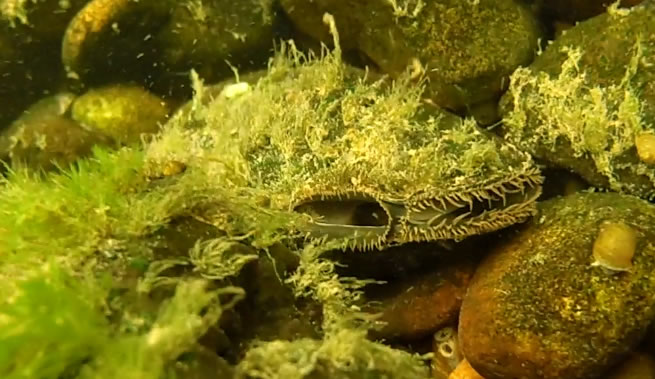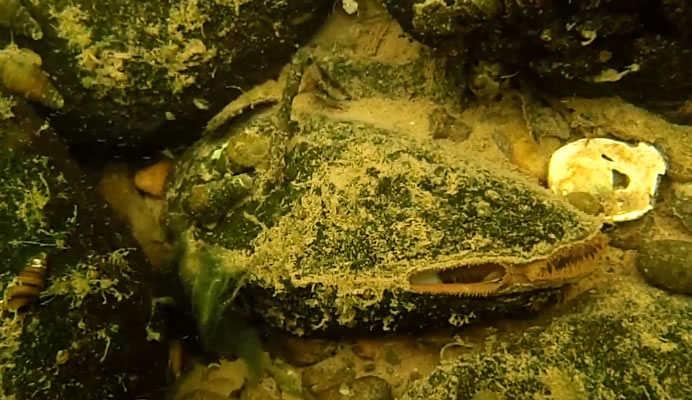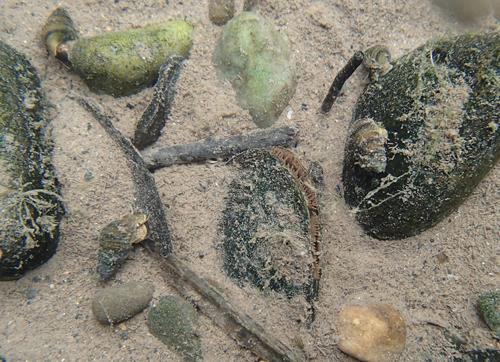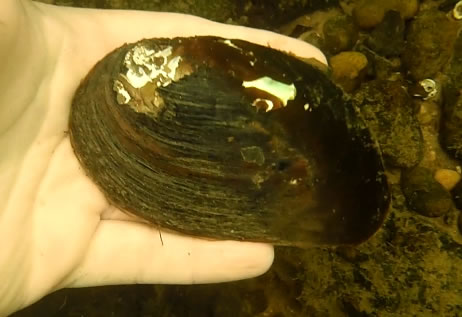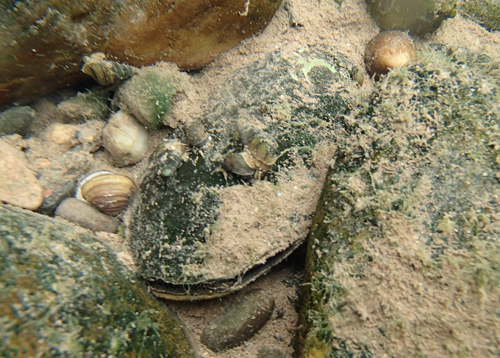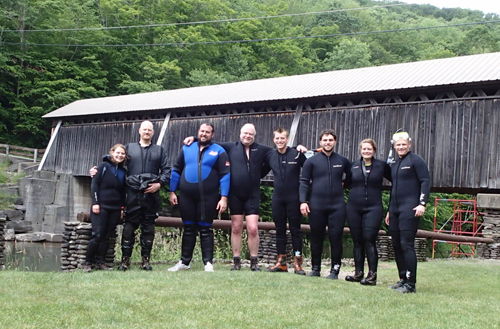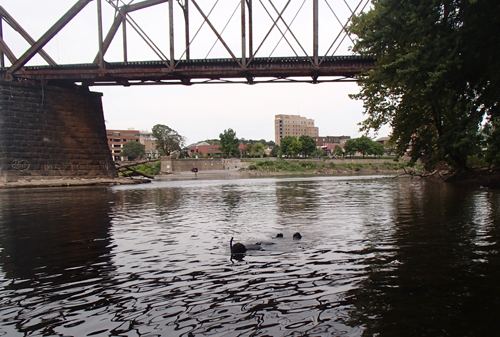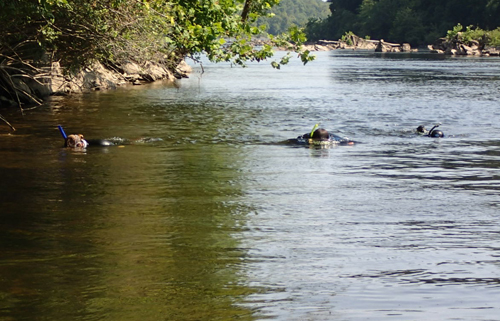Delaware • New Jersey • Pennsylvania
New York • United States of America
 |
Did you know that freshwater mussels can live to be 100 years old or older? The shells of these centenarians bear the scars of time spent pummeling against boulders and scraping through sand; some may have seen the Delaware River's Flood of Record in August 1955, others perhaps the flood events of the early twentieth century. Three generations back, some may have seen George Washington crossing the Delaware in 1776, though they may ultimately have been captured and punched through with holes to make buttons in a time before plastic (see photo on left).
Today, we understand that freshwater mussels are most valuable alive, living in rivers and streams, lakes and ponds. They stabilize streambeds, especially during floods, provide food and habitat needed by other animals and plants, and, most importantly, as filter-feeders, mussels clean the water in which they live, improving water quality. They suck water in, trap solids (dirt, algae, and other pollutants) in their gills, and then release clean, filtered water back into the water column. Each mussel can filter a gallon of water or more every day. And, since mussels can live a long time, they are also very sensitive to pollution, making them a good indicator of a river or stream's overall health.
Mussels are considered one of, if not the, most at risk animal group in the United States, with many species considered threatened or endangered by state and federal governments. The mainstem Delaware River persists as a stronghold for Atlantic-slope mussel diversity, including populations of the federally endangered dwarf wedgemussel (Alasmidonta heterodon), the state listed yellow lampmussel (Lampsilis cariosa), and high densities of the common eastern elliptio mussel (Elliptio complanata). While there has been a good amount of research on freshwater mussels in the upper and middle sections of the Delaware River and its tidewaters, much less was known about mussel populations in the river's lower non-tidal section below the Delaware Water Gap and above Trenton, N.J.
In 2000 and 2001, with funding from the National Park Service, the U.S. Geological Survey's Northern Appalachian Research Laboratory (USGS-NARL) in Wellsboro, Pa. conducted comprehensive, qualitative mussel surveys of the Upper Delaware Scenic and Recreational River and the Delaware Water Gap National Recreation Area.
In 2013, to build on this previously-completed survey work, DRBC and USGS-NARL, leveraging funding from the National Park Service and other sources, proposed to conduct a study to provide a snapshot of mussel distribution and density in the Lower Delaware Scenic and Recreational River, the river section just below the Delaware Water Gap, starting at the Portland-Columbia footbridge and ending at the head-of-tide in Trenton, N.J. Since one of the goals of the Lower Delaware survey was to be able to compare findings with the surveys completed in the upper and middle sections of the river, the methods used were similar to those of the 2000 and 2001 surveys; this proved very reliable for providing consistent and comparable data points.
In the spring of 2013, a DRBC mussel survey team was assembled and trained (in the field and from available literature) to properly observe and identify freshwater mussels in the river. Surveys were conducted in three phases throughout the summer of 2013 over a period of seven weeks. The first phase included rapid float surveys, in which a paired team in a canoe paddled downriver and observed whether mussels were present or absent. They would also stop at unique habitat types - islands, back channels, areas of interest - and perform spot snorkel surveys to record mussel counts and species identification. These surveys showed the relative distribution of mussels in varying substrate types, habitats, river configurations, flow regimes, distance from tributaries, and surrounding landscape types.
Intensive, random snorkel surveys were also completed in 200-meter segments, moving downriver with the current in 15-minute increments. To do so, team members donned their snorkel gear, held their breath, and dove down. They scanned between rocks, searched amongst aquatic plants, and looked closely at the riverbed. Each team member was assigned a different position from the river shoreline. These flanking lanes of survey prevented mussels from being double-counted and gave an interesting sense of how mussels are distributed through different depths and substrate types throughout the river profile gradient.
The third phase was a multi-day intensive snorkel survey to examine diversity and abundance break-points in the Delaware River around the Lehigh River confluence to determine whether there was a difference in counts and species distribution above or below the Lehigh's confluence.
Looking between the Portland-Columbia footbridge and the head-of-tide at Trenton, the surveyors found more than 25,000 mussels - 1 for every 51 seconds of searching! While the most common species was by far the eastern elliptio, five other species were found, as well as juveniles. The below video, complete with narration and underwater footage, provides a short overview of the surveys. It was compiled and narrated by mussel survey team member Eric Wentz.
Considering that earlier estimates said there may be few to no mussels in the Lower Delaware River, the results of this survey are a good sign that freshwater mussels are re-establishing in this river section as its water quality improves from a polluted past. Healthy populations of mussels mean better water quality, a healthier ecosystem, and a safer environment for swimming, recreation, and fishing in the largest undammed river east of the Mississippi.
DRBC has analyzed data collected from the freshwater mussel survey to help determine the best habitat and water quality for different species in the Lower Delaware River. A final report was completed and submitted to the National Park Service (link below).
Freshwater Mussel Community Composition and Relative Abundance in the Lower Delaware River (pdf 691 KB; Dec. 2014)
Copyright © Delaware River Basin Commission,
P.O. Box 7360, West Trenton, NJ 08628-0360
Phone (609)883-9500; Fax (609)883-9522
Thanks to NJ for hosting the DRBC website
